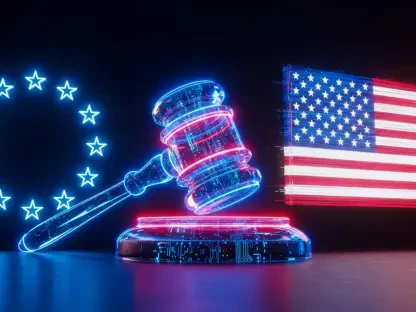A legal controversy in Quincy, Massachusetts, has arisen as a group of local residents has taken action to oppose the installation of two Catholic saints’ statues at the entrance of a new public safety building. Their lawsuit against the city and its mayor, Thomas Koch, centers on halting what they perceive as a violation of constitutional principles regarding the separation of church and state. This case contributes to the national dialogue on how governmental entities approach symbolic religious expressions in public spaces.
Legal and Constitutional Concerns
Constitutional Separation of Church and State
The core of the lawsuit is grounded in constitutional principles, with the residents arguing that the proposed statues infringe upon the separation of church and state. They assert that the expenditure of over $760,000 of taxpayer funds to create and erect these religious symbols constitutes a government endorsement of a specific religion, thus defying the state constitution. From the plaintiffs’ perspective, such actions not only violate legal guidelines but also undermine the principle of governmental neutrality in religious matters, vital for maintaining the pluralistic essence of American society.
This legal initiative earmarks broader concerns, reflecting ongoing national debates on public religious symbols funded by taxpayer dollars. These conflicts frequently arise when communities question whether government involvement in religious displays unduly favors one faith over others. By filing their complaint in Norfolk Superior Court, these Quincy residents join numerous others across the nation who have similarly challenged religious installations as a breach of First Amendment rights.
Precedents and Broader Implications
In examining this dispute, it is essential to consider its place within a wider landscape of similar legal confrontations in the United States. A notable comparable instance is the Louisiana case, where multiple families contested a law mandating the display of the Ten Commandments in public schools. These families argued that the law violated the constitutional guarantee of religious freedom by promoting a specific set of beliefs. The resolution of that case through the judicial system underscores the complexities inherent in such constitutional dilemmas.
These legal confrontations typically yield significant precedents that influence future judgments and legal strategies. Courts’ interpretations of the First Amendment consistently aim to strike a balance between permitting cultural expressions and upholding governmental neutrality in religious affairs. As such, the Quincy case is emblematic of a broader tendency to scrutinize public funding for religious symbols, serving as a potential referential point for upcoming legal challenges about religious and secular boundaries.
Public Opinion and Diverse Perspectives
Balancing Cultural Heritage and Constitutional Mandates
The legal challenge in Quincy brings to the forefront the often contentious debate surrounding the role of cultural heritage within public spaces, specifically in religious manifestations. Some in the community view religious symbols, such as statues of saints, as integral to the collective historical fabric, displaying a rich cultural tapestry within the public domain. They argue that these symbols do not necessarily equate to governmental endorsement of religion but instead celebrate diverse cultural identities.
Conversely, those opposing the installation stress the importance of maintaining a clear divide between church and state. They argue that public spaces should remain secular, especially when funded by taxpayer resources, to ensure inclusivity and neutrality. Proponents of this view maintain that allowing religious displays in public entities could marginalize other belief systems and blur the lines between cultural acknowledgment and unconstitutional government endorsement.
The Broader Societal Reflection
Cases like the one in Quincy reflect a larger societal examination of how religious and secular identities coexist within shared public spaces. As American society becomes more diverse, so does the necessity for respectful and equitable treatment of all religious beliefs. Legal challenges related to religious displays highlight the enduring need to navigate these complexities thoughtfully. Judiciary outcomes in such cases help define the limits of religious freedom and government involvement, influencing policy and public perception.
These battles often serve as mirrors reflecting ongoing public discourse on achieving harmony between honoring tradition and upholding the separation between religious and governmental spheres. Ultimately, they play a pivotal role in shaping the policies that define communal living and ensure rights are consistently applied across divergent populations, irrespective of individual religious affiliations.
Fostering Equity and Inclusivity
The Role of Courts in Shaping Outcomes
Courts remain central in resolving disputes over religious displays, with decisions often setting influential precedents. These legal platforms are tasked with interpreting constitutional guarantees in a manner that fosters an equitable society. Judges must balance respecting cultural heritage with upholding the foundational principle of church-state separation to ensure government neutrality.
Legal resolutions in these disputes have far-reaching consequences, shaping community policies and influencing national discussions. By creating a legal framework that subtly guides local and state decision-making, courts play a critical role in ensuring that constitutional protections are uniformly upheld, allowing for a society that values diversity under the law.
Pursuing Solutions for Future Harmony
A legal dispute has emerged in Quincy, Massachusetts, where a group of locals has set forth a lawsuit to prevent the installation of statues depicting two Catholic saints at the entrance of a newly constructed public safety building. This legal action targets the city and its mayor, Thomas Koch, arguing that the presence of religious imagery violates the constitutional doctrine of the separation of church and state. They contend that placing religious statues in a government setting might blur the boundaries between governmental practices and religious endorsements, which they believe should remain distanced in a secular society. This situation is reflective of broader national conversations on how public officials navigate the inclusion of religious symbols in public spaces. As communities across the nation grapple with issues involving religious symbolism and governmental domains, Quincy becomes another focal point in the ongoing dialogue concerning religious freedom and governmental neutrality.









